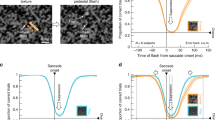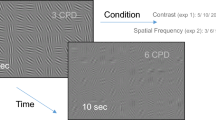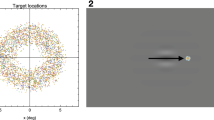Abstract
INABILITY to perceive one's own eye movement in a mirror is a common observation. To explain this, Holt1 was the first to propose a central inhibitory mechanism. On the other hand, Dodge2,3 and Woodworth4 claimed that retinal blurring could account for the apparent suppression and pointed out that a blurred image could be seen if the illumination was increased in intensity. Volkman5, using tests for visual acuity and threshold, stated that although vision was not “blanked out” during eye movements, visual recognition and resolution were markedly diminished, as opposed to steady fixation. LaTour6 found that the chance of perceiving a flash three log units above threshold was markedly decreased during the 50 ms before the onset of the voluntary eye movement. He also noted that the chance of flash perception did not return to normal until one or two hundred ms after the onset of eye movement. Zuber, Stark and Forbes7, also using psychophysical methods, confirmed LaTour's observation. They also noted that pupillary response to light decreased about 60–70 ms before the onset of eye movement. Gross, Vaughan and Valenstein8 found that the peak to peak amplitude of the visual evoked response (derived on a signal averaging computer) showed a marked decrease just after the onset of an eye movement and did not return to normal for 100–200 ms. They did not examine the visual evoked responses which occurred before the onset of the voluntary saccade.
This is a preview of subscription content, access via your institution
Access options
Subscribe to this journal
Receive 51 print issues and online access
$199.00 per year
only $3.90 per issue
Buy this article
- Purchase on Springer Link
- Instant access to full article PDF
Prices may be subject to local taxes which are calculated during checkout
Similar content being viewed by others
References
Holt, E. B., Harvard Psychol. Studies, 1, 3 (1967).
Dodge, R., Psychol. Rev., 7, 454 (1900).
Dodge, R., Psychol. Bull., 2, 193 (1905).
Woodworth, R. S., Psychol. Bull., 3, 68 (1906).
Volkman, F. C., J. Opt. Soc. Amer., 52, 571 (1962).
LaTour, P. L., Vision Res., 2, 261 (1962).
Zuber, B. L., Stark, L., and Forbes, M., Exp. Neurol., 14, 351 (1966).
Gross, E. G., Vaughan, H. G., and Valenstein, E., Electroenceph. Clin. Neurophysiol., 22, 204 (1967).
Kris, C., Medical Physics, 3 (edit. by Glasser, O.), 691 (Yearbook Publishers, 1960).
Krauskopf, J., Graf, V., and Gaarder, K., Amer. J. Psychol., 79, 1, 73 (1966).
Author information
Authors and Affiliations
Rights and permissions
About this article
Cite this article
DUFFY, F., LOMBROSO, C. Electrophysiological Evidence for Visual Suppression prior to the Onset of a Voluntary Saccadic Eye Movement. Nature 218, 1074–1075 (1968). https://doi.org/10.1038/2181074a0
Received:
Revised:
Issue Date:
DOI: https://doi.org/10.1038/2181074a0
Comments
By submitting a comment you agree to abide by our Terms and Community Guidelines. If you find something abusive or that does not comply with our terms or guidelines please flag it as inappropriate.



